Works of applied arts have appeared in ritual and ceremonial functions from time immemorial. They have influenced human life both practically and symbolically. They have served in religious services and secular events, in every kind of celebration, and have helped strengthen the fundament of society, its common values and ideas.
Rituals can be understood as invariable modes of behaviour, symbolic physical performances and practices with fixed rules. Similarly to how myths form the cultural system of conventions that maintain cohesion in society. They allow people to manage the twists and turns of life, the forming of fellowships, the acceptance of a new stage or status in life (baptism, confirmation, marriage, death, etc.). They operate and assist almost supernaturally where purely rational attitudes fail to suffice. Ritual elements permeate many everyday activities as well. But the major rituals of faith, power, or protection were accorded solemn significance and, like all ceremonies, turned man towards higher, sacred values. They represent a departure from the rhythm of everyday banalities.
Collective rituals and ceremonies have always drawn their power from symbolic actions and gestures, as well as from dedicated items. This is especially true for Christian worship (liturgy), which has a practice interwoven with the use of valuable liturgical vessels and vestments, often of exquisite artistic worth. Such artefacts became an integral part of rituals and celebrations and co-determined their form and appearance. These items gave rituals and celebrations the character of impressive artistic productions.
More text next to the photos
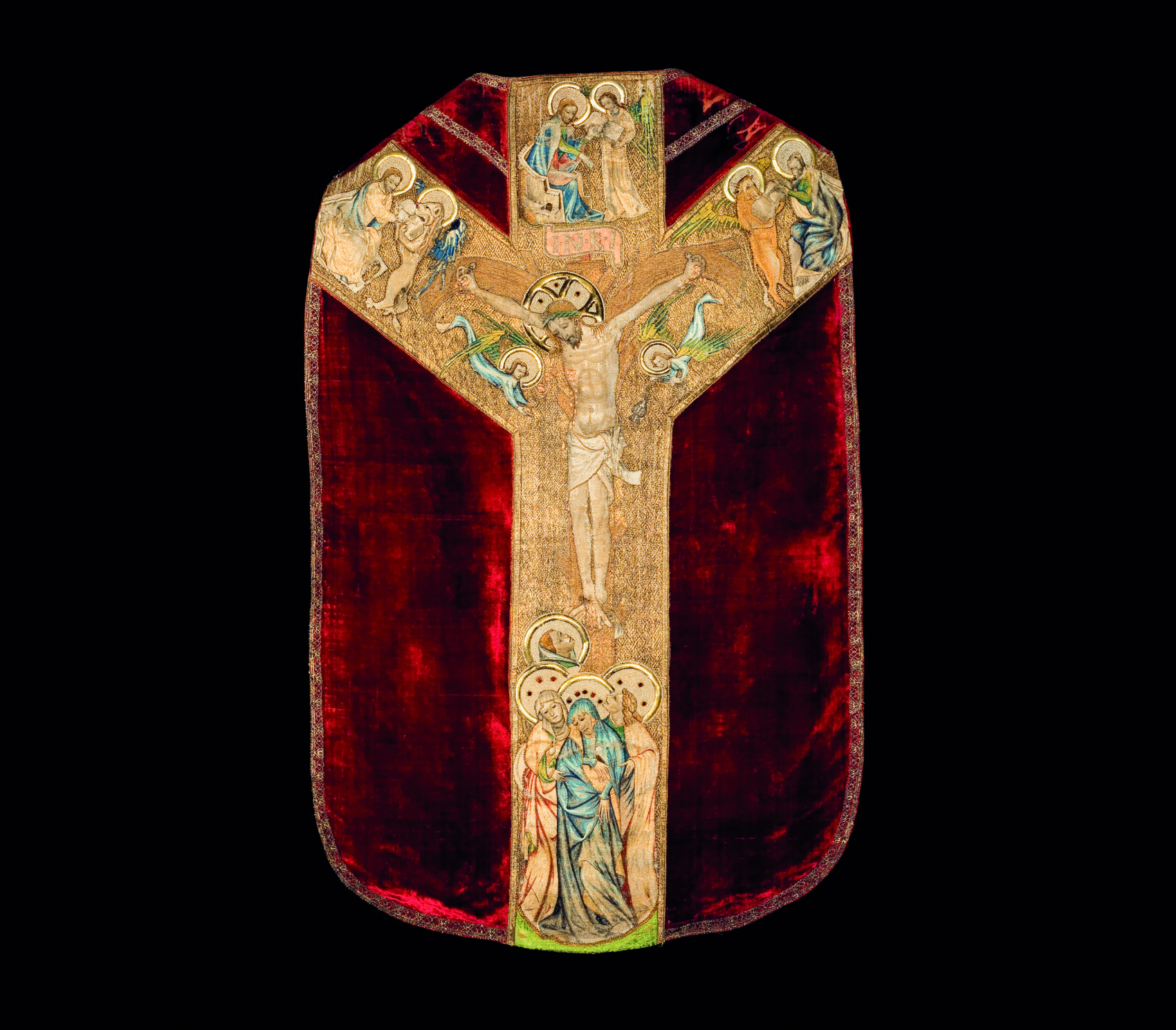
Liturgical clothing and textiles, termed paraments, played an irreplaceable role in emphasising the sacred nature of religious rites. Most liturgical clothes were shaped according to ancient Roman fashion and did not change much. One exception is the outer garment worn by a priest during Mass – the chasuble, which was reduced to give more freedom to the arms. The priest would also wear a long girdled shirt (alb), a stole around his neck, a maniple on his left arm, and an oblong cloth on his shoulders called an amice. For other services outside the Mass, he wears a semicircular cloak (cope). The signature vestment of a deacon (a candidate priest) is the dalmatic. Outer vestments were generally made of silk dyed in the appropriate liturgical colour – white is for great feast days such as Easter and Christmas, red is for the commemoration of martyrs, purple (and pink) for Advent and Lent, black for funeral services, and green for the remaining days of the year. The cross is a testament to the superb artistry and craftsmanship of Bohemian needlework under the Luxembourg dynasty. The figure embroidery has a stylistic affinity with paintings from the period, namely, with the works of the Master of the Třeboň Altarpiece. Christ’s body is flanked by two angels, who emphasise the Eucharistic meaning of the scene – one holds a chalice to collect Christ’s blood, the other wields a censer. Depicted on the arms of the cross are the Evangelists Mark, Matthew, and Luke, while the Three Marys and St John the Evangelist stand at the foot of the cross. The embroidery originated from the Benedictine monastery in Prague-Břevnov; during the Hussite Wars, it was removed to Broumov Monastery for safe keeping. In the Baroque era, two Medieval embroideries of different periods and purposes were attached to a single chasuble – the cross on the back and the cope hood on the front. They were separated again when the chasuble was restored in 1971.
Orphrey cross on the so-called Broumov Chasuble, late 1370s with later modifications
Prague. Embroidery with silk (split stitch and others) and metallic threads on linen, metal and fabric appliqués, pearls, stones, silk velvet. Benedictine Archabbey of St Adalbert and St Margaret in Prague-Břevnov (on long-term loan in UPM)
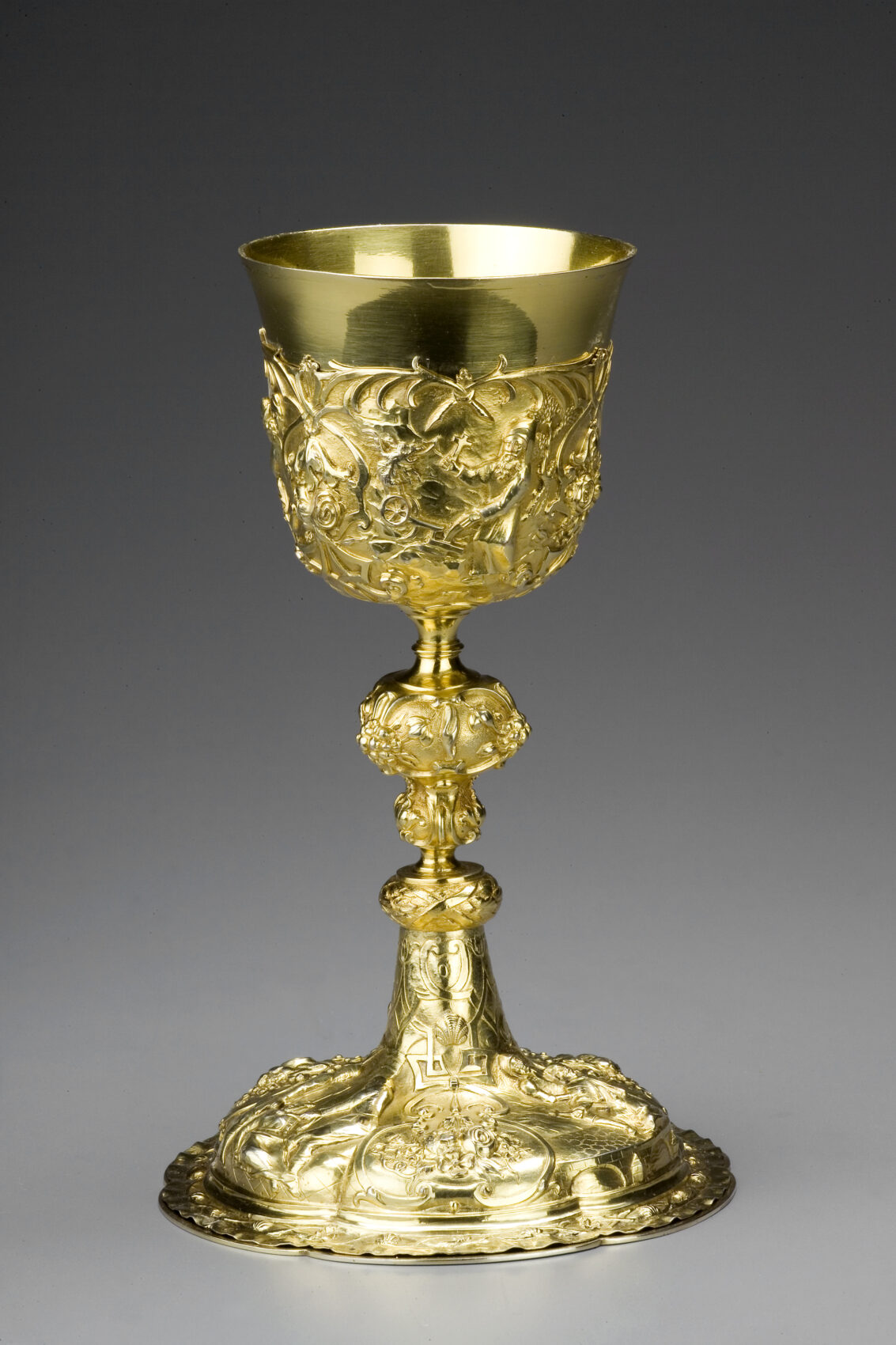
The Eucharist holds a central place in Christian life and liturgy. It is not merely a “thanksgiving” (from Greek eucharistein, to give thanks), but also a direct encounter with God. The Mass culminates in the Liturgy of the Eucharist. Central to it is the breaking of bread – a reminder of the Last Supper and of Christ’s broken body on the cross. The wafer of bread (Host) and the wine then become, in substance, the actual body and blood of Jesus Christ. The Catholic faith believes that Christ gives himself as the food and drink of a new, eternal life. When the faithful receive the Eucharist during Holy Communion, they are united with Christ and the Church.
Chalice with scenes from the lives of the patron saints of the Czech lands, 1725, Franz Michael Redelmayer (1689–1749), Prague. Silver, embossed, chased, and gilt
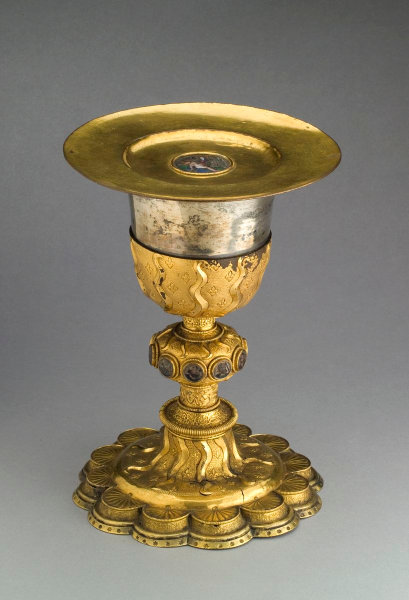
Special vessels are also used. The consecrated bread and wine are kept in the paten and the chalice. The chalice is covered by the pall and the veil, both made of cloth. During Mass, the chalice and paten are placed on a linen corporal, which is kept in a burse. The consecrated Hosts are kept in a ciborium, pyx, or custodia, while a monstrance is used to display them for public adoration. The monstrance is often shaped like the sun, with a glass case in the centre and a crescent clasp, or lunula, to hold the Body of Christ.
Chalice with paten, c. mid-16th century, Paris. Copper, embossed, stamped, and gilt; silver, enamel
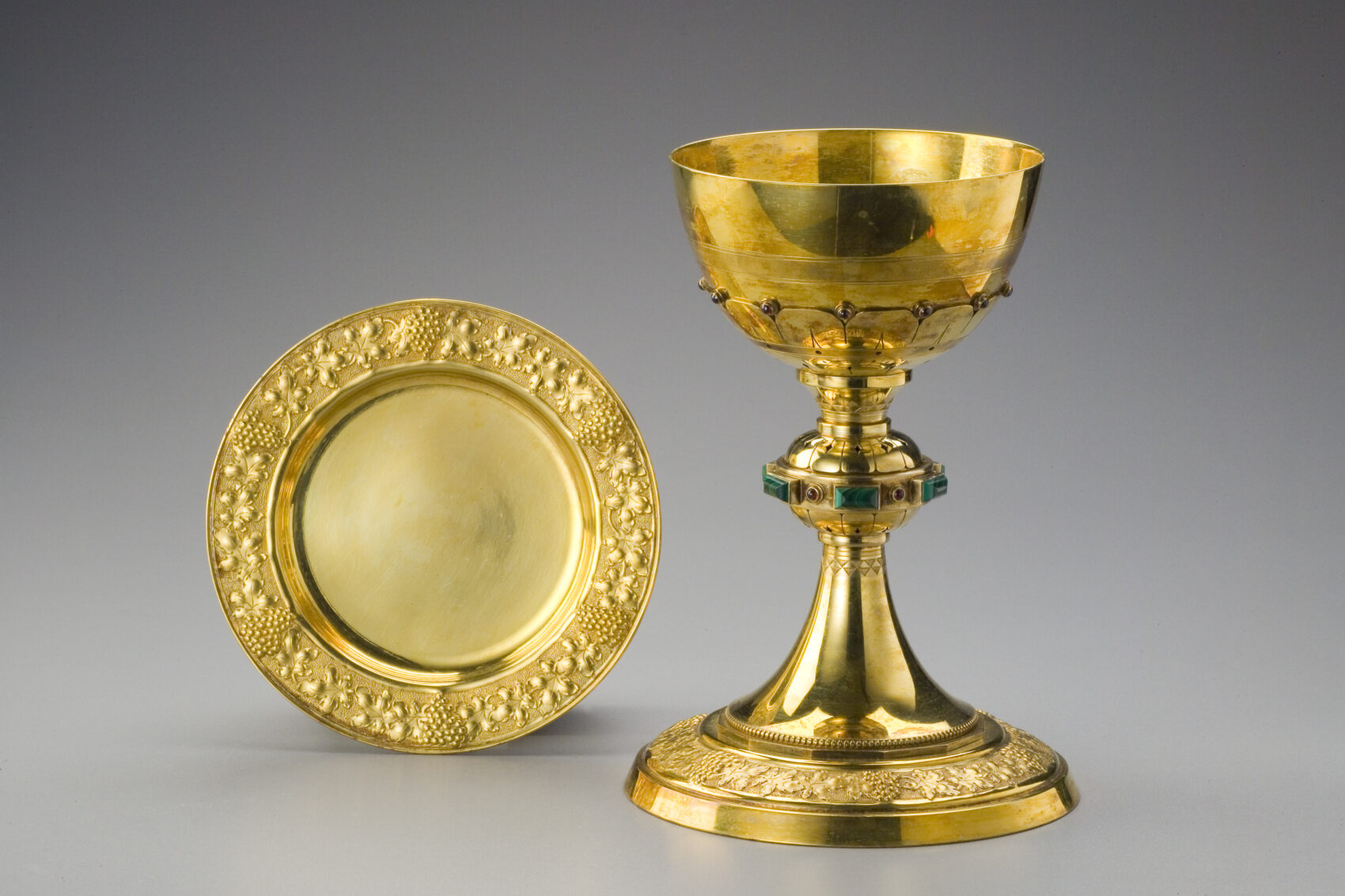
The chalice is used in Christian liturgy for the sacrifice, consecration, and communion of wine. The shape, material, and details of the chalice imbue its practical function with a symbolic dimension. The chalice consists of the base, the stem with an enlarged middle section called the node, and the cup.
Chalice and paten, after 1929. Jan Staněk (active 1891–1953), Prague. Silver, embossed, chased, and gilt; Bohemian garnets, malachites
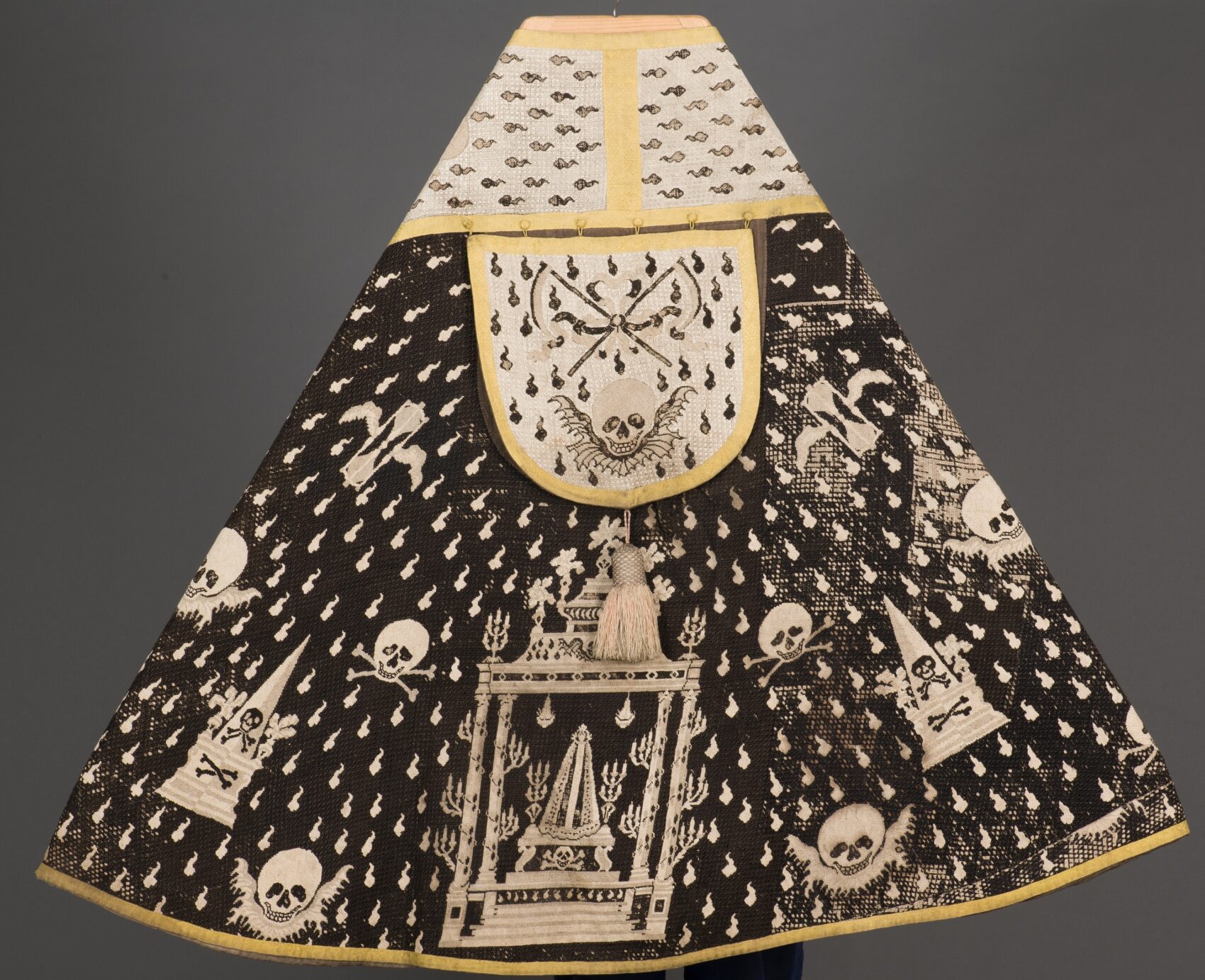
Vestments worn for funeral services were distinguished by their black, or later also purple, colour. This cope features a contrasting black-and-white combination, with motives of death and ephemerality covering the entire surface. Depicted are coffins on a catafalque with ceremonious architecture, embellished with candles, crests, and draperies (castrum doloris), winged skulls with crossed bones, hourglasses, scythes, and shovels. All of these motives are linked together with raining fire. The cope falls under a broader group of funeral paraments; it stands out with its full silk embroidery.
Funeral cope, c. 1700. Central Europe. Linen, embroidery with silk and chenille (petit point and running stitch). Premonstratensian Canonry in Strahov (on long-term loan in UPM)
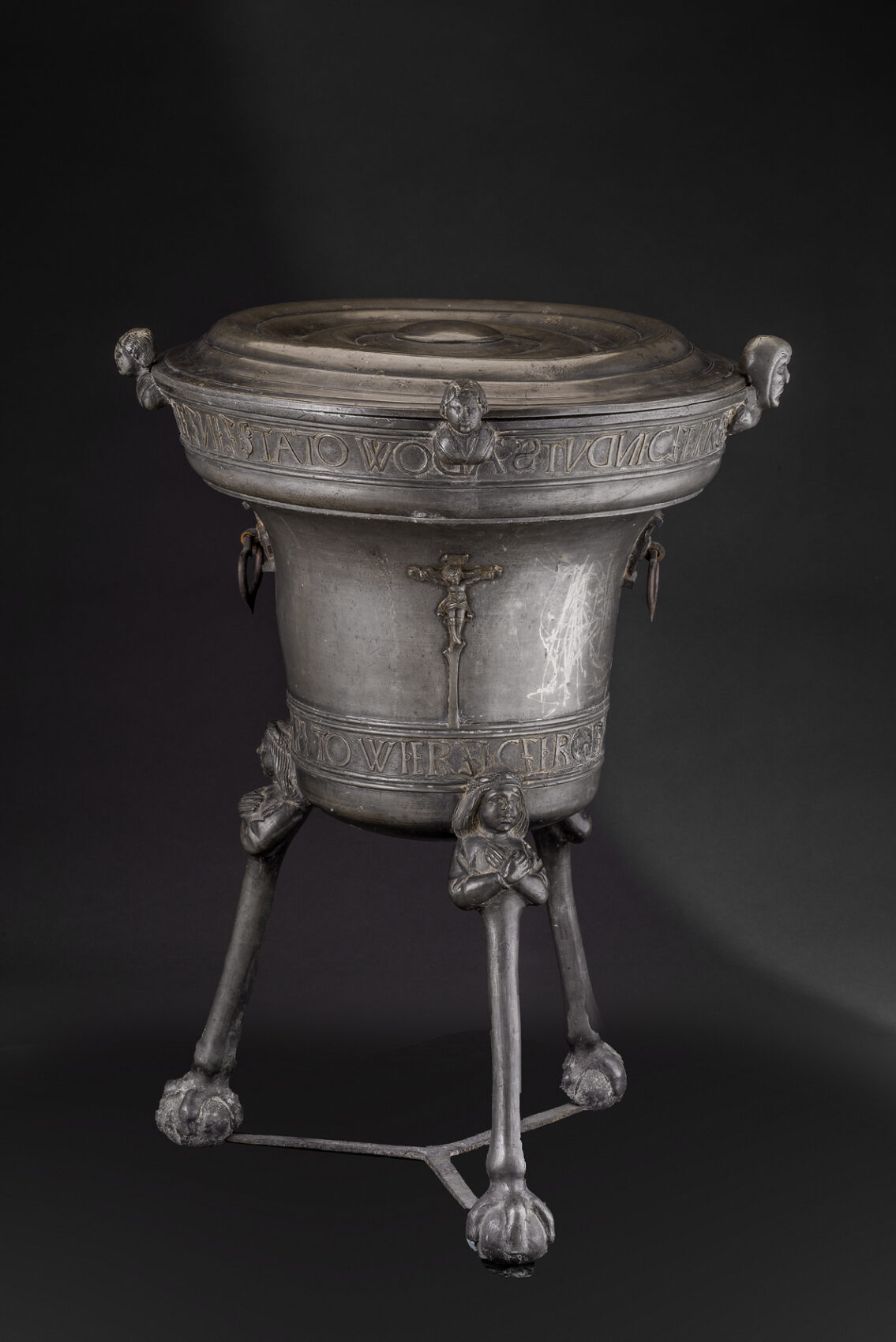
Baptism, Confirmation (Christian maturity), and the Eucharist are sacraments – outward signs of the inward grace given to the faithful by God. Sacraments remind Christians of the life and passion of Jesus Christ, and they strengthen faith and resolve. Specific words and symbolic rituals – cleansing by water, anointing, Communion – function as “instruments of grace” bestowed by God. Other sacraments in the Catholic tradition include the Sacraments of Penance (confession of sins), Marriage, Holy Orders (priesthood), and Anointing of the Sick. These seven sacraments are complemented with minor sacramentals, such as blessings. Baptismal fonts hold the holy water that is used for one of the most momentous events in the life of a Christian: baptism. The oldest fonts were generally made of stone, with a brass bowl inside; metal ones are documented from the late 12th century. Baptism by water marks the beginning of a new life, as it signifies “the cleansing of original sin”, as claimed by the inscription on this baptismal font, which probably originated from around Smiřice. It is shaped as an upturned bell; the lid is held up by three sculpted busts. The legs were cast into the half figures of servants. The areas between the inscriptions are decorated by a relief showing Christ Crucified and the figure of St Stephen.
Baptismal font from Smiřice, 1541. Václav Farář (documented 1516–1561), Hradec Králové. Pewter, cast and engraved; wrought iron
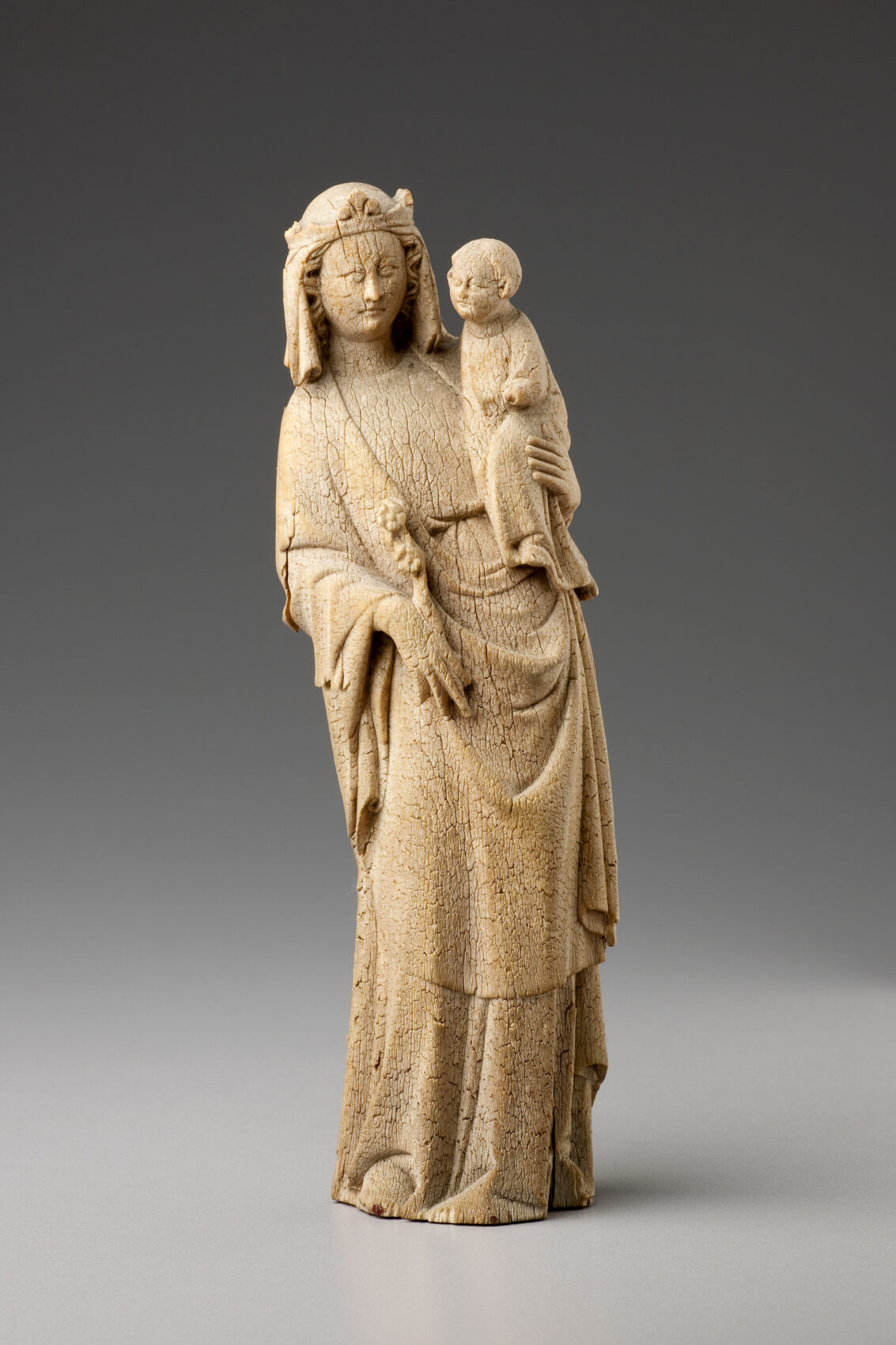
Relics are the bodily remains of martyrs, saints, and other people worthy of emulating. They are honoured mainly by Christians of Catholic and Orthodox denominations, but some Asian religions have similar customs. Relics can also be items that were in contact with the saint’s body, such as clothes or instruments of torture. Reliquaries are decorative containers used to preserve and display the relics. They can have various forms, such as reliquary crosses or pax-crosses, used during Mass for the symbolic “kiss of peace”. Relics were also mounted in spectacular displays from cloth, wires, and other materials, typical of monastery works. Relics were thought to have miraculous powers, and they were placed inside altars and protective amulets. In the Czech lands, the country’s patrons were the most revered – Sts Vitus, Wenceslas, Ludmila, Adalbert, John of Nepomuk, and others. Many devotional sculptures survived because they later changed their function. This Madonna in the French Gothic style, which was brought to the Czech lands by a member of Napoleon’s army, was originally part of a small altar presented to a family in the Moravian town of Olešnice. Members of the family removed the statue from the altar and placed it in a niche on their house for protection.
“Madonna of Olešnice”, 1320–1340, Paris. Ivory
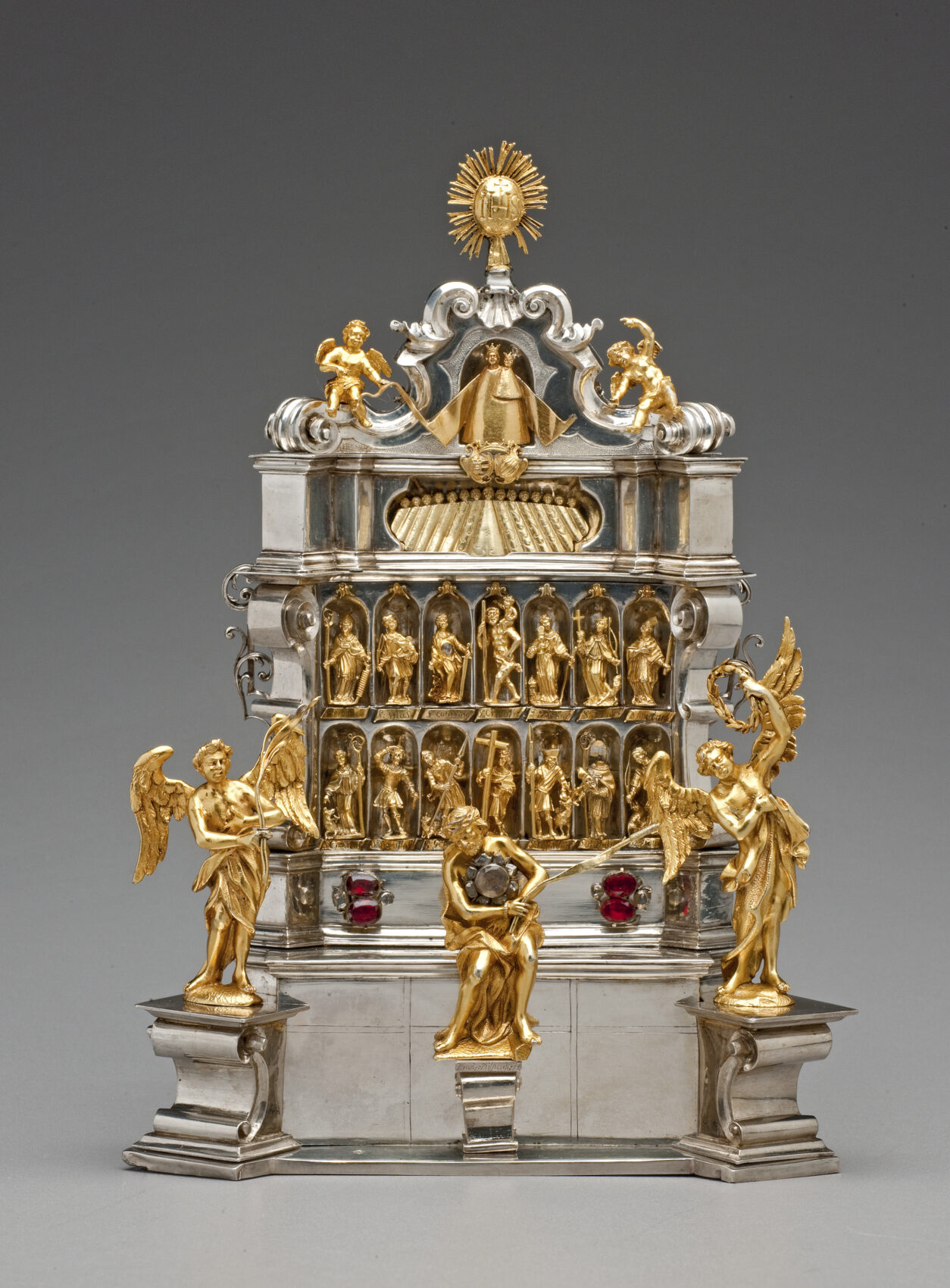
New Christian spiritualities, such as medieval mysticism, revival movements (Franciscans), or “contemporary devotion” (devotio moderna), led to a greater emphasis on the personal relationship between man and God and on genuinely lived faith. An individual’s connection to God was facilitated by domestic devotions and prayers, supported by home altars, prayer books, and small devotional articles – objects of private devotion that included statues, pilgrimage badges, holy pictures, crucifixes, or rosary beads. This miniature copy of the miraculous altar of the Fourteen Holy Helpers from the Franciscan monastery in Kadaň served as a private reliquary, both to safeguard relics and to commemorate the well-known pilgrimage site. The statuette of Christ the Sufferer is backed by a group of venerated saints. In the top row from the left: St Erasmus, St Vitus, St Catherine, St Christopher, St Barbara, St Margaret, and St Giles; in the second row: St Blaise, St Pantaleon, St George, St Agathius, St Eustace, St Denis, and St Cyriacus. Above them stands the Madonna in a Baroque robe; at her feet are the coats of arms of Hermann Jakob, Count of Czernin, and his wife Maria Barbara, née Schaffgotsch. The Rococo miniature is the work of two superb goldsmiths based in the Small Side of Prague.
Home altar with the Madonna of Kadaň and the Fourteen Holy Helpers, 1748–1749
Franz Michael Redelmayer (1689–1749) and Franz Christoph Diesbach Jr (1696–1766), Prague. Silver, cast, chased, and gilt; almandines, diamonds, rock crystal
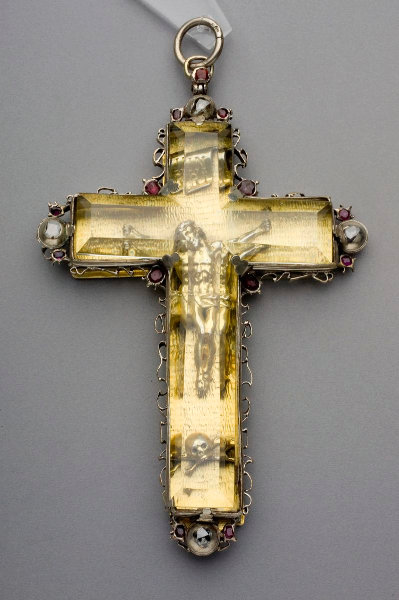
Bishops, some abbots, and other eminent church dignitaries are accorded the special privilege of using insignias known as pontificals. Episcopal insignias include the mitre (hat), crosier (staff), ring, and pectorale (a cross worn on the chest). The outer vestment (chasuble) is supplemented by gloves, a dalmatic worn symbolically underneath, and previously also low shoes (also known as sandalia, or sandals) and stockings. During Mass, bishops would sit on an honorary ecclesiastical throne. At a pontifical Mass, the sitting bishop would have a gremiale placed on his lap – a cloth that originally served to protect his outer vestments.
Pectoral cross, 1st half of 18th century, Central Europe. Silver, gilt; diamonds, Bohemian garnets, glass
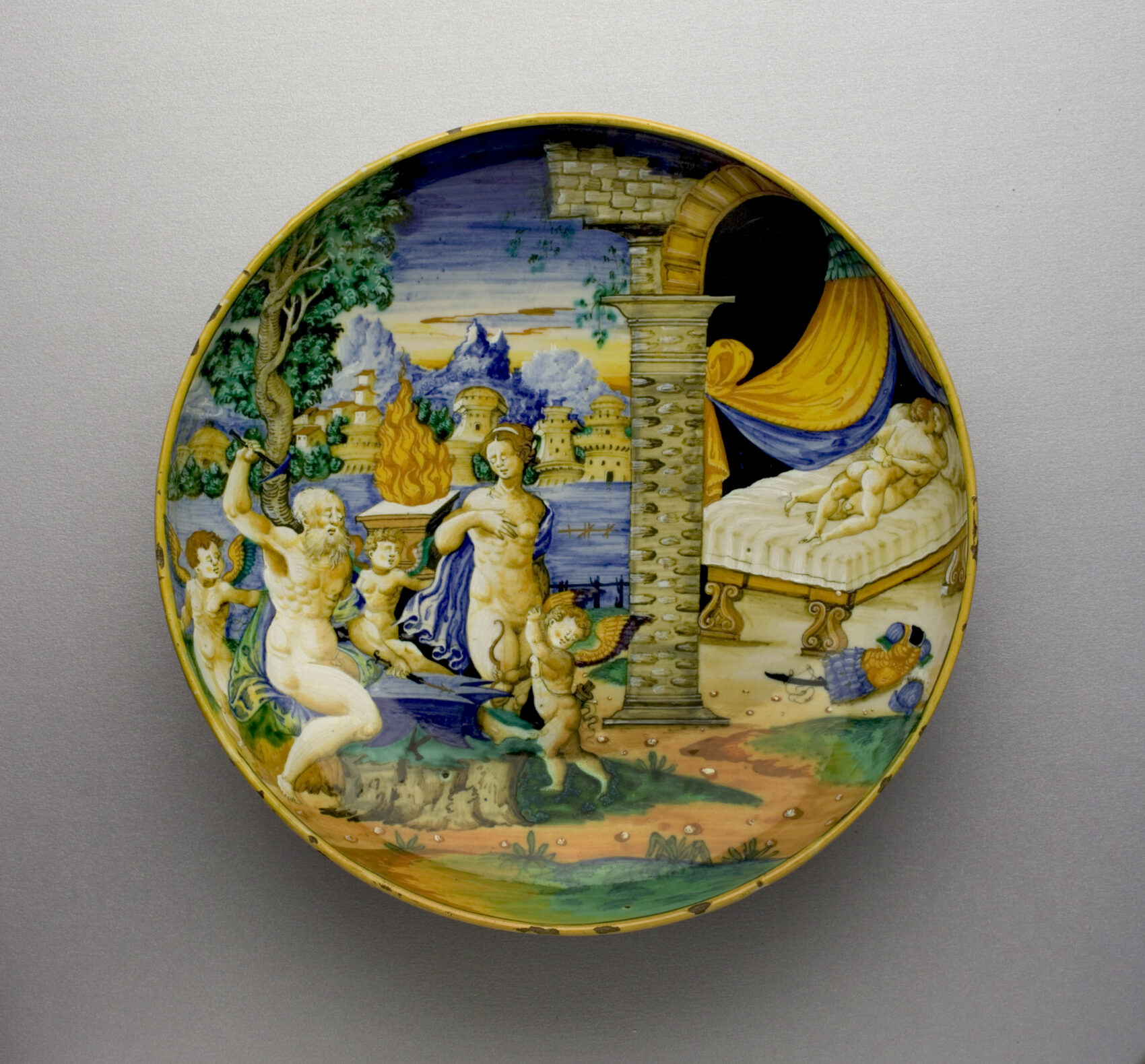
Celebrations have always fused rituals and myths – stories that imbue a human community with cohesion and greater purpose. This can be seen in the figural designs on Italian maiolica of the 16th century, especially the work of Urbino masters in istoriato style.These works are rightly regarded as some of the masterpieces of Renaissance pottery art. They tell the mythical stories of the birth and meaning of our world, as seen by Ovid, Virgil, and others. The images symbolically depict love and passion (Venus and Vulcan, Peleus seizing Thetis), government and divine protection (the sea god Neptune), or key scenes of political representation and identity (Aeneas as the mythical founder of Rome).
Dish with Venus and Vulcan, c. 1550, Urbino, Italy. Maiolica, painted in high-temperature colours
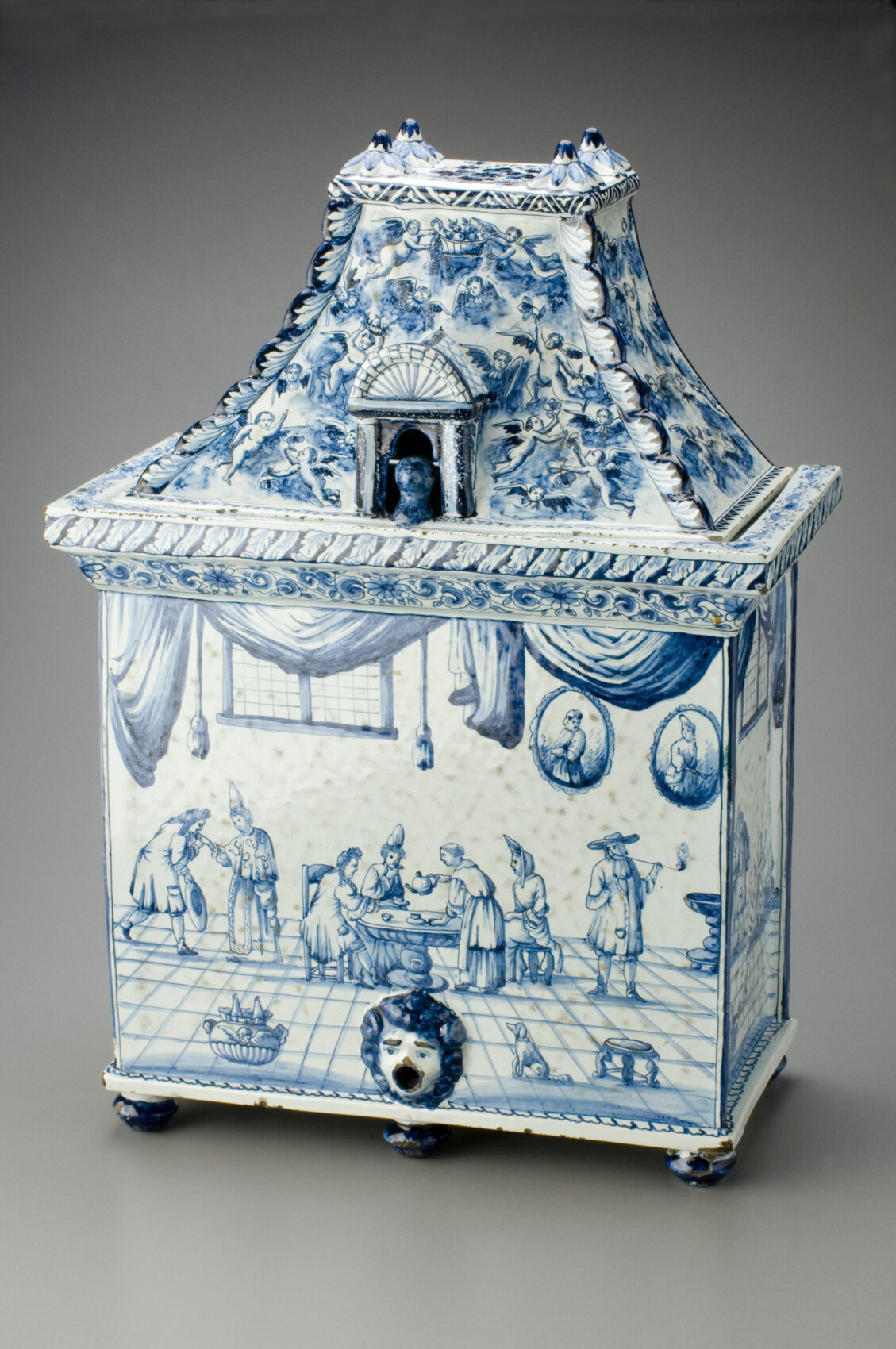
The growing volumes of imported Oriental goods in the 17th century could not meet the demand for precious Chinese porcelain, which was used as representative interior ornamentation and as tableware in the Baroque era. Efforts to imitate it in Europe brought about significant progress in ceramics, which in turn led to expanded applications at banquets and for changing dining customs. The best imitations of porcelain from the mid-17th century onwards came from the Dutch workshops in Delft. Elegant Delft faience, painted after Chinese patterns in cobalt blue and later in vibrant colours, was counted among the most luxurious of Baroque goods throughout the whole of the following century.
Lavabo in the shape of a house with a scene of an ongoing feast, 1701–1722. Pieter Adriaenson Kocks, “De Grieksche A” workshop, Delft, Netherlands. Faience, white-glazed; cobalt painting
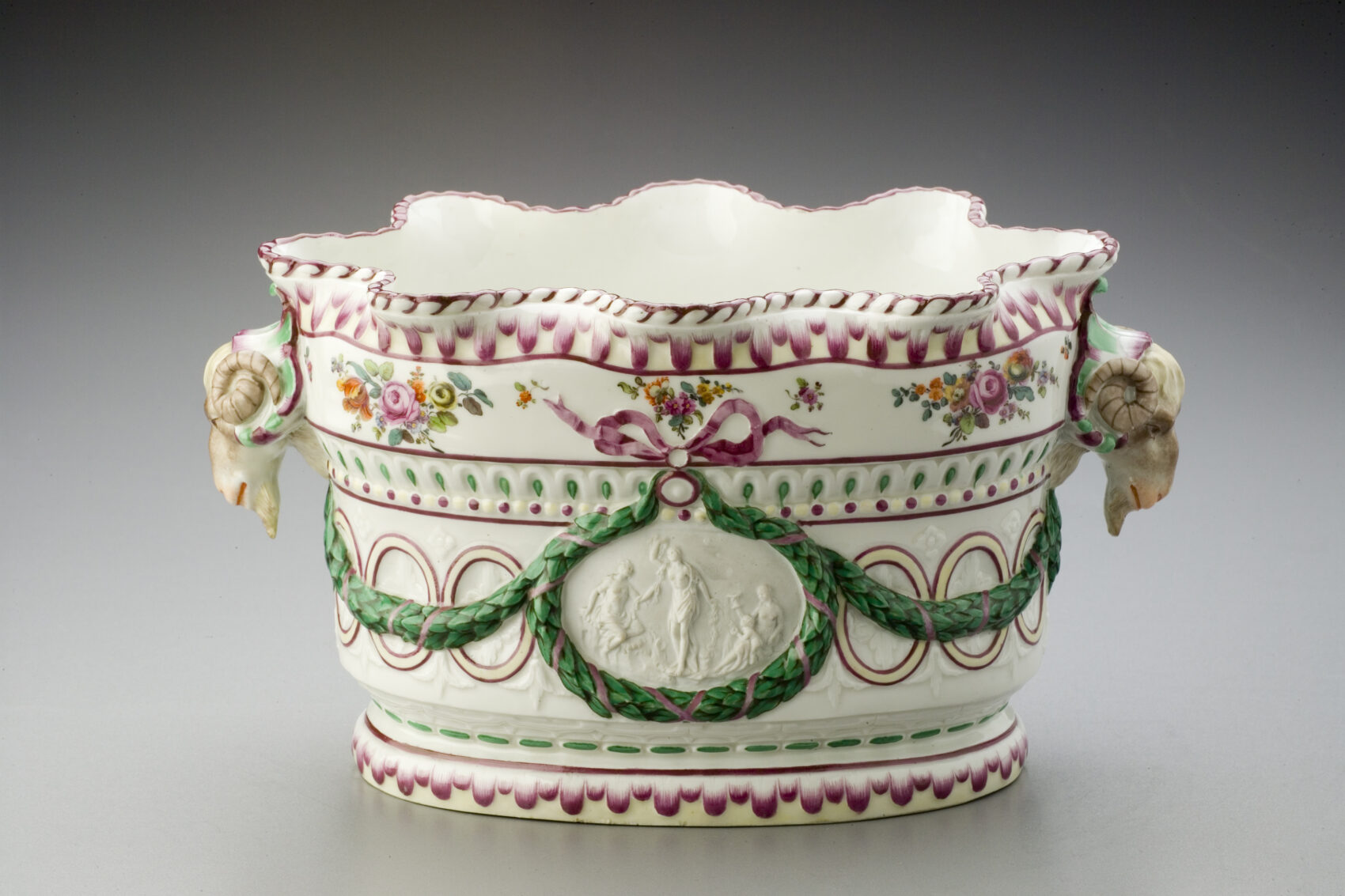
As a luxury material of high value, Meissen porcelain brought about a fundamental change in tableware and dining culture. Delicate white porcelain offered completely new opportunities for the sculpting and production of drinkware and dinnerware sets. The consumption of exotic hot beverages – tea, coffee, hot chocolate – developed into dignified rituals of social magnitude, which was further emphasised by the use of porcelain tableware. New shapes of teapots, cups, and saucers were created in Meissen, and the arrival of Johann Gregorius Höroldt ushered in new techniques and designs of painted decorations. The wealth and diversity of Rococo shapes and patterns culminated in the works of Johann Joachim Kändler. He was also responsible for advancing the decorative dominance of porcelain sculptures in banquets. Dining culture became a modern ritual, co-formed by and reliant on the use of porcelain.
Ice bowl, c. 1780, Vienna. Painted porcelain
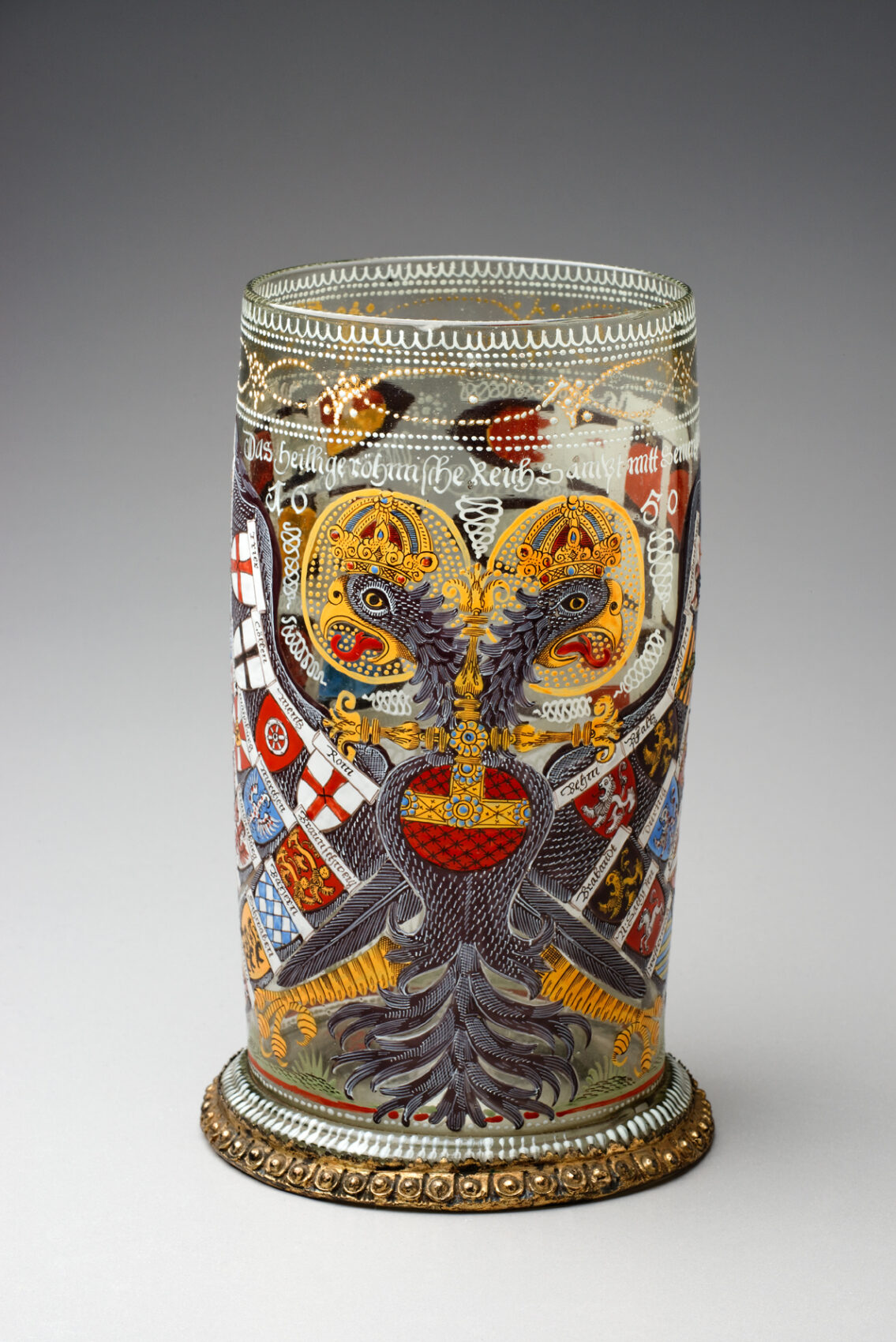
Humpens functioned as ceremonial vessels from the late 16th century, and they were alternatively known as willkum, or “welcome beakers”. This was reflected by their customary enamelled ornamentation. Frequent motives include the symbol of the Holy Roman Empire, the two-headed eagle with the emblems of Imperial States on its wings, or the Holy Roman Emperor accompanied by his seven electors. Other representative beakers were decorated with the coats of arms of noble families, crafted for a celebration or to memorialise some life event. The latter case is exemplified by the beaker that commemorates the marriage of Smil Osovský of Doubravice, Chief Justice of the Margraviate of Moravia and Imperial Counsellor to Rudolph II, to Katharina of Waldstein in 1589.
Humpen with the two-headed eagle of the Holy Roman Empire, 1650, Central Europe. Enamelled glass, silvered and gilt fitting
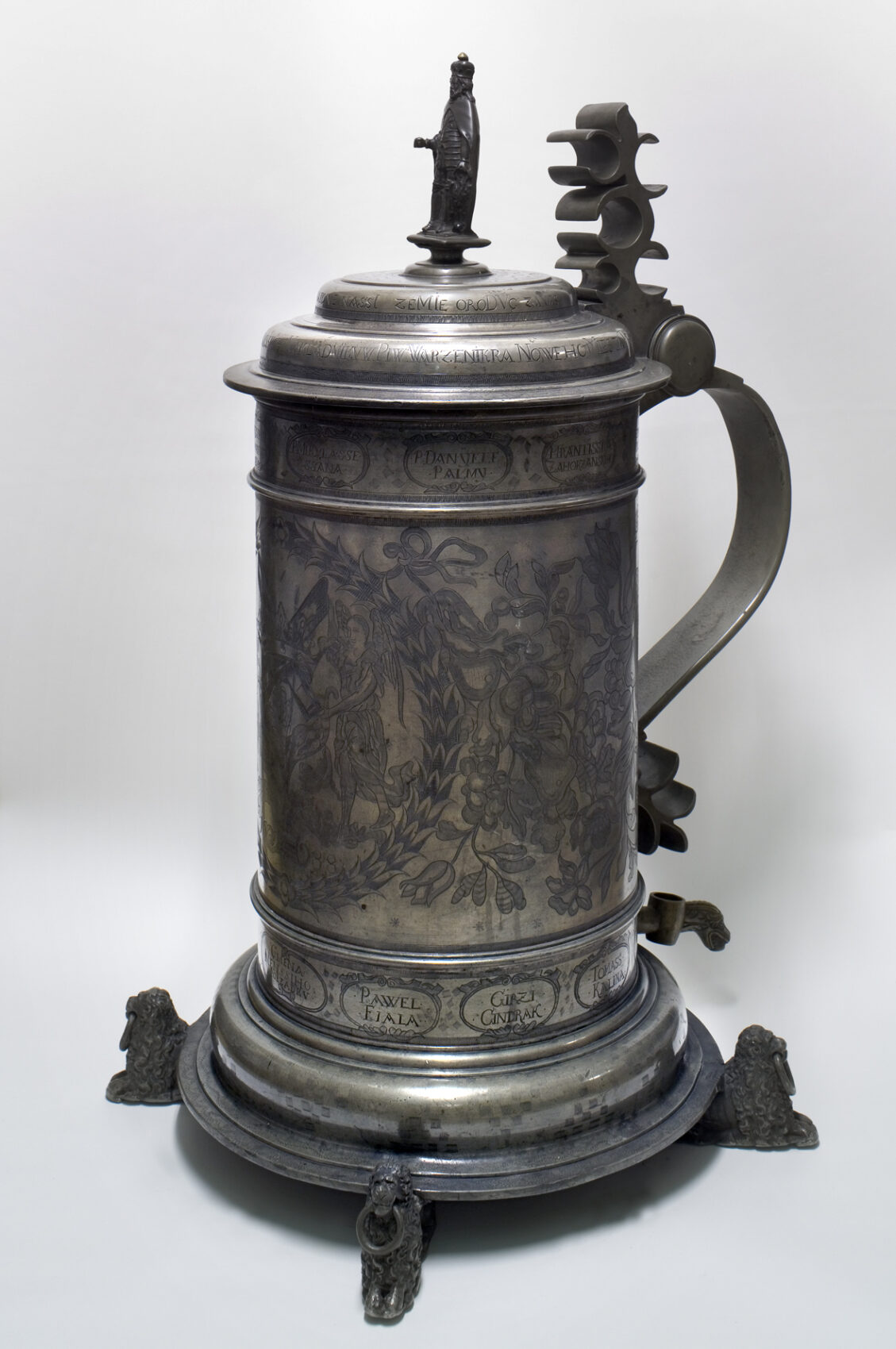
Unique pewter tankards and vessels were essential components of the representative paraphernalia of craft guilds from the late the 15th century. They played a major role during ceremonies and special occasions, such as the naming of journeymen or at banquets following processions or funerals. They were part of the guild’s trappings and often referenced the organisation’s patron saint – in the case of the New Town Brewers, St Wenceslas. Similar ceremonial drinking vessels were also procured by brotherhoods and societies. For example, the book-shaped flask with an engraving of St George commemorated the winner of “shooting at the bird”, a traditional associational contest in target shooting.
Tankard of the New Town Brewers’ Guild with the figure of St Wenceslas, 1688. Kašpar Ondřej Schödel (c. 1653–1704), Prague (New Town). Pewter, cast and engraved; brass
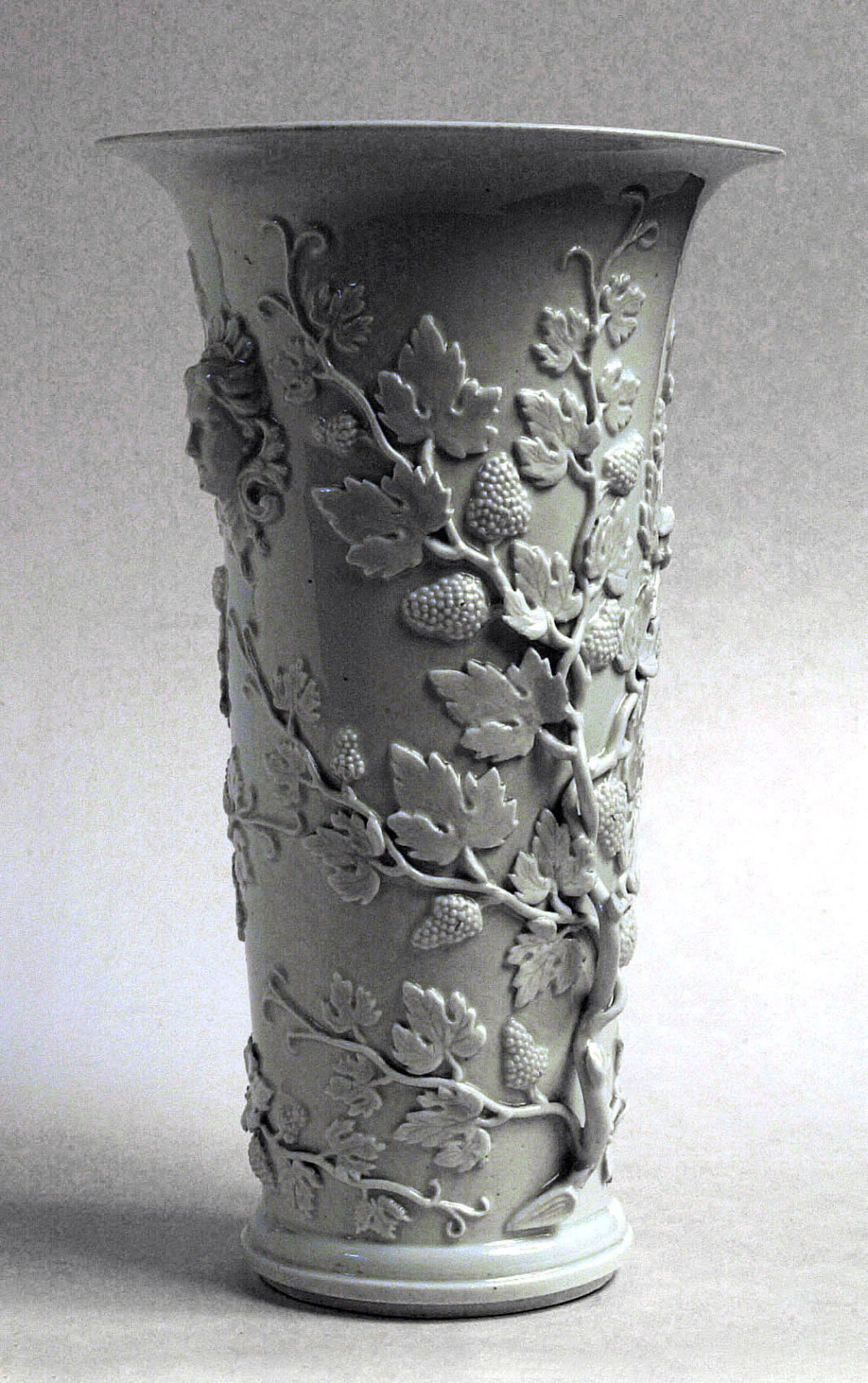
The first efforts to produce European porcelain, supported by Augustus II the Strong, Elector of Saxony, resulted in 1707 in a brown stoneware with practical qualities rivalling the imports from the Far East. The collaboration between the alchemist Johann Friedrich Böttger and the naturalist Ehrenfried Walther von Tschirnhaus soon led to the discovery of white porcelain and the founding of the first European porcelain works in Meissen in 1710. Vases made of Böttger porcelain, with mascarons and grapevines are among the first products of the Meissen manufactory. Their design was largely influenced by their modeller, the Dresden court goldsmith Johann Jakob Irminger.
Vase with raised decoration, 1715–1720. Modelled by Johann Jakob Irminger (1664–1724)? Meissen. Böttger porcelain
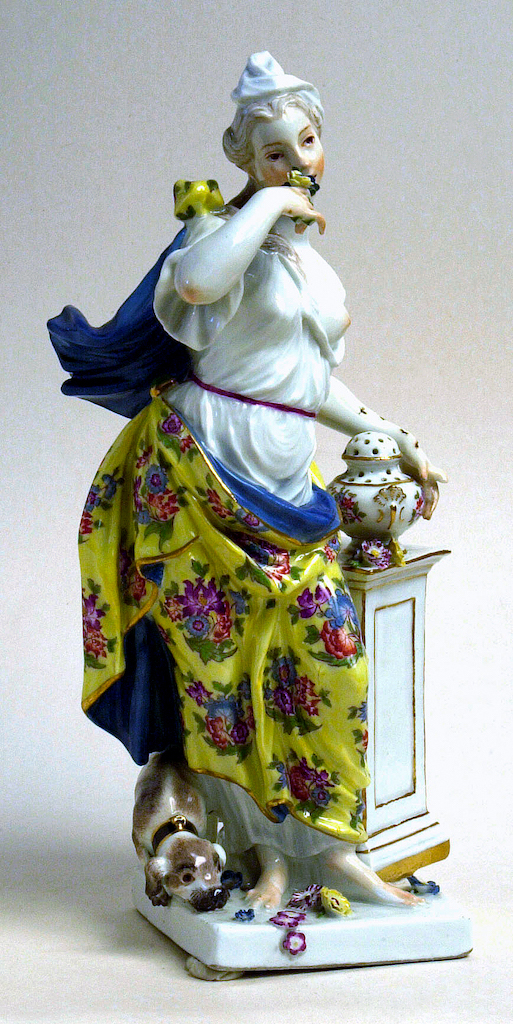
Vibrant polychrome porcelain figural sculptures were essential tablepieces after 1740; the diverse themes included mythological figures or allegories of the five senses, or the times of the day or seasons of the year. Together with intricately modelled confectionery and other ornaments, they provided for a richly decorated banquet setting.
Allegories of Sight and Smell from the Five Human Senses, c. 1745. Modelled by Johann Joachim Kändler (1706–1775) and Johann Friedrich Eberlein (1695–1749). Meissen. Porcelain, painted and gilt
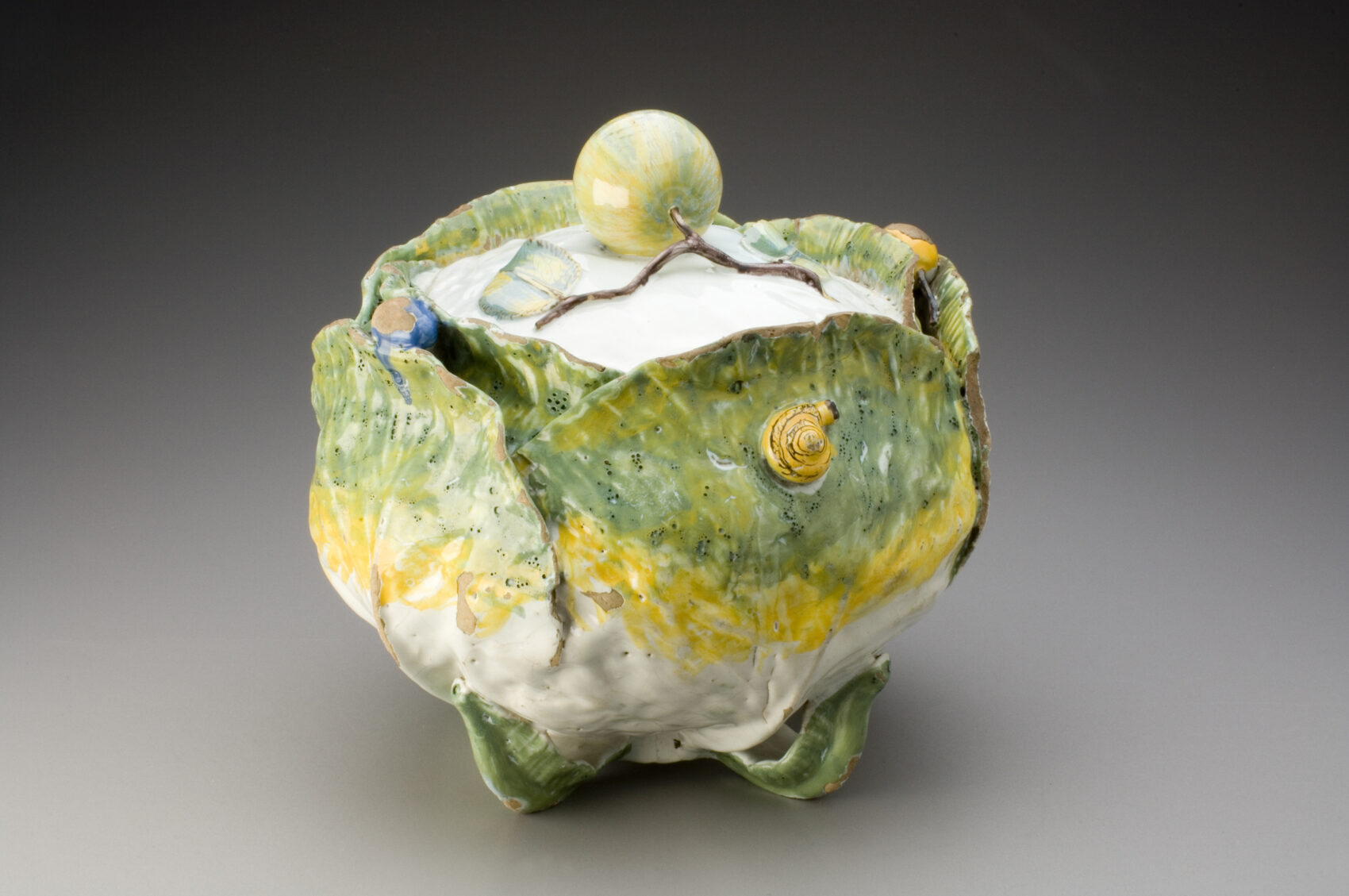
The ceramic manufactory in Holíč (Weißkirchen/Holitsch) was established in 1743 by Francis I Stephen of Lorraine, the husband of Empress Maria Theresa. Its output of vibrantly coloured, sculpted Rococo tableware, with terrines and jugs in the shape of vegetables or birds drew on French works from Strasbourg. The manufactory was the first company to produce faience in the Austrian monarchy, and the period of 1750–1760 saw it rank among leading European producers.
Terrine in the shape of a cabbage, c. 1760, Holíč (Weißkirchen/Holitsch), Slovakia. Faience, overglaze painting
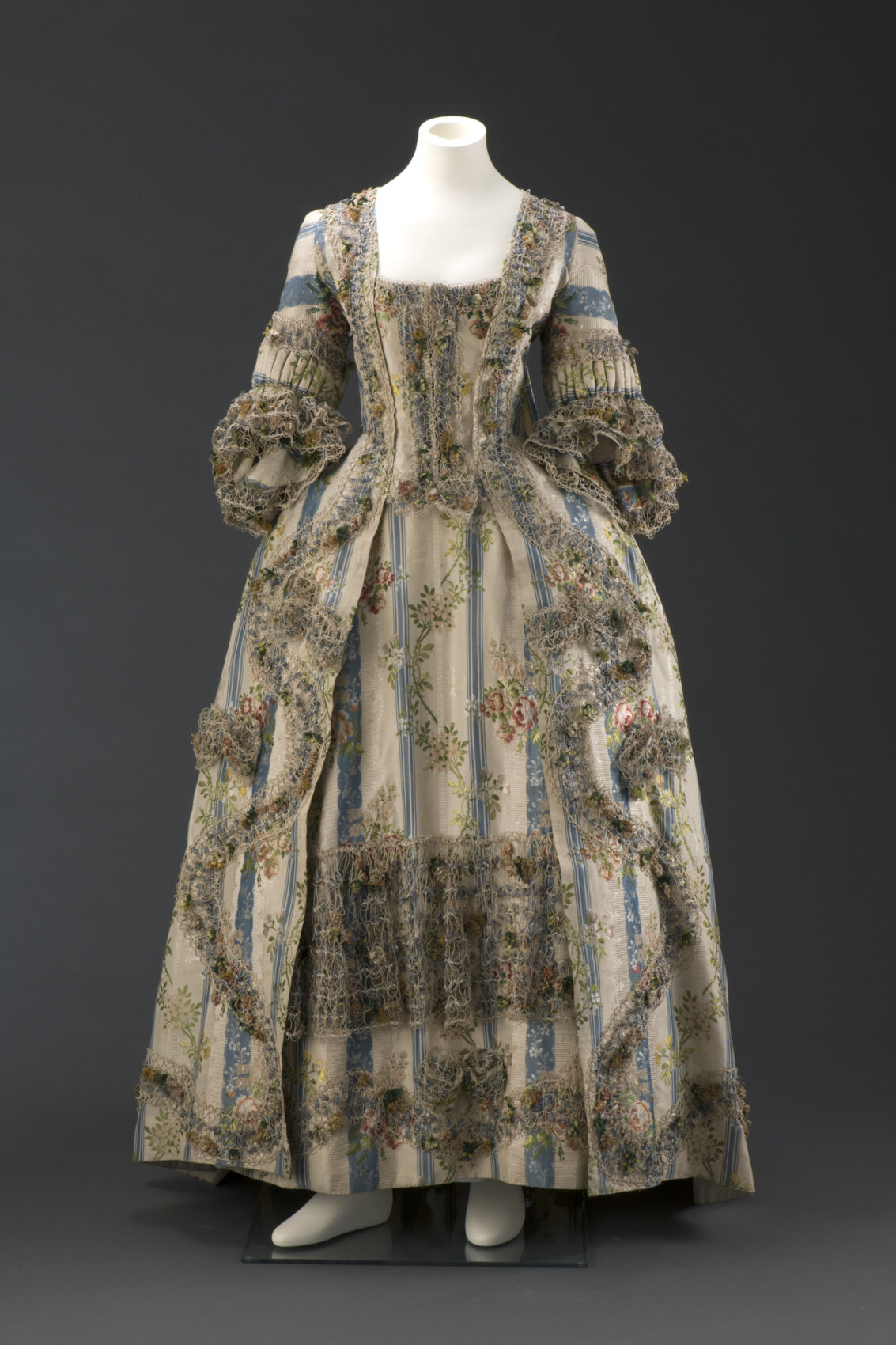
Baroque festivities would be unimaginable without expensive, showy clothing. Rococo dresses “à la française” from the 3rd quarter of the 18th century represent the final phase of the Baroque “Watteau” style, featuring a sack-back gown with a fitted bodice and a free-flowing back that extended down to a train. The underskirt is widened at the hips and supported by side hoops, or “panniers”. In the 1770s, this lavish fashion was only worn to satisfy the ceremonial expectations of the court; everyday ladies’ fashion began to prefer the more simple “à l’anglaise” style with a fitted back and no panniers. Further developments tended towards simplicity, and besides a number of variants in “à l’anglaise” style, loose-fitting dresses made of light, gauzy fabrics were also worn, along with certain elements adapted from men’s fashion.
Women’s dress in Rococo style (dress and underskirt), 1760–1780. Fabric from France, sewn probably in Bohemia. Striped silk with woven pattern and brocaded motives
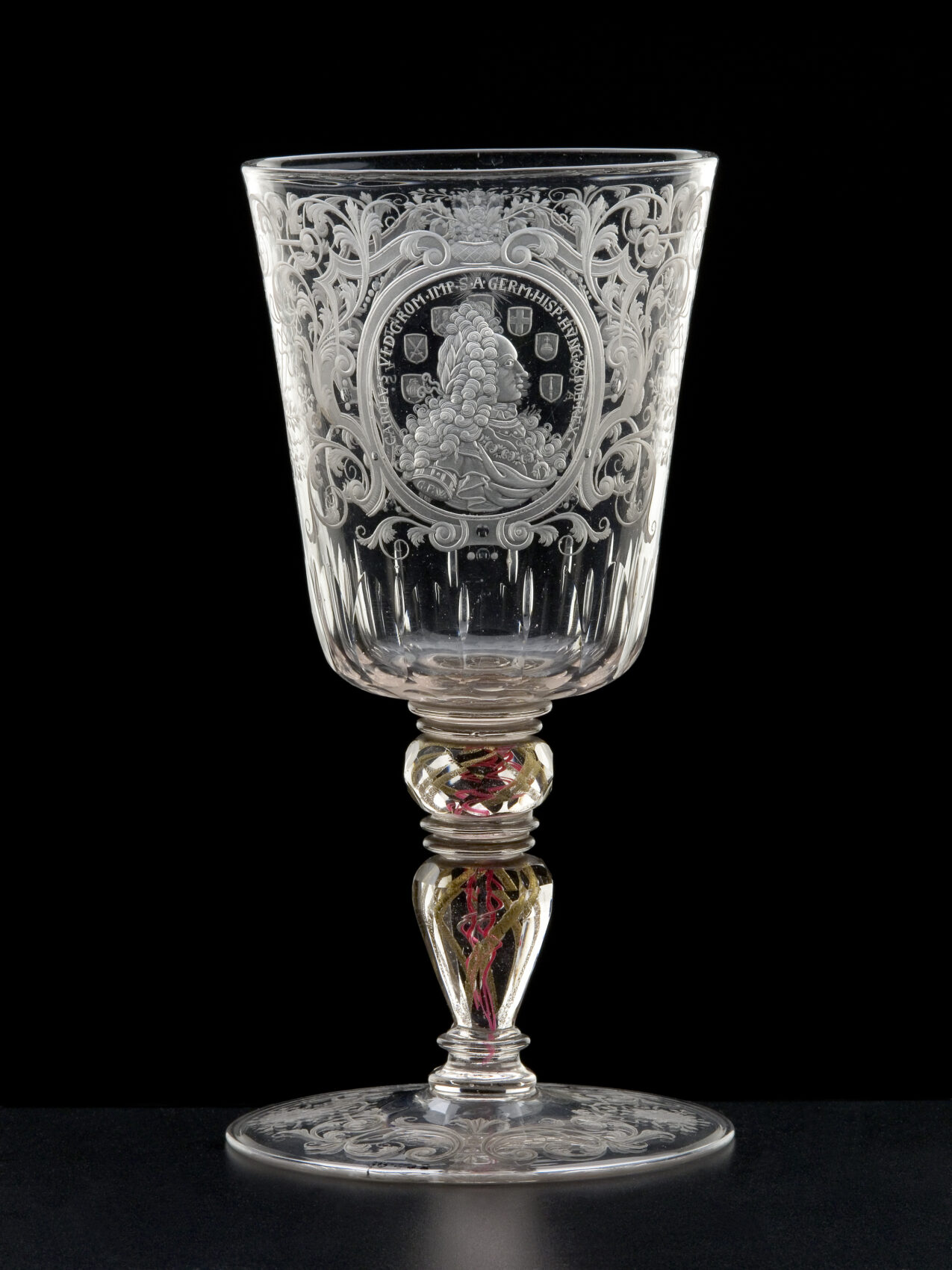
Efforts to imitate precious rock crystal with glass culminated in the last third of the 17th century with the discovery and refinement of the production of crystal glass. The hardness and optical brilliance of potassium-calcium glass enabled the development of glass-cutting – an immensely demanding technique that is closely connected to Bohemian glassmakers. Interest in Czech Baroque cut glass brought an end to the glory of Venetian glass. Unique baluster-stem goblets cut with the portraits of rulers, coats of arms, allegories, and mythological scenes, richly ornamented, were luxury items used for ceremonious occasions.
Goblet with a portrait of Emperor Charles VI, 1711–1720, North Bohemia. Glass, cut and engraved; fused ruby and gold threads
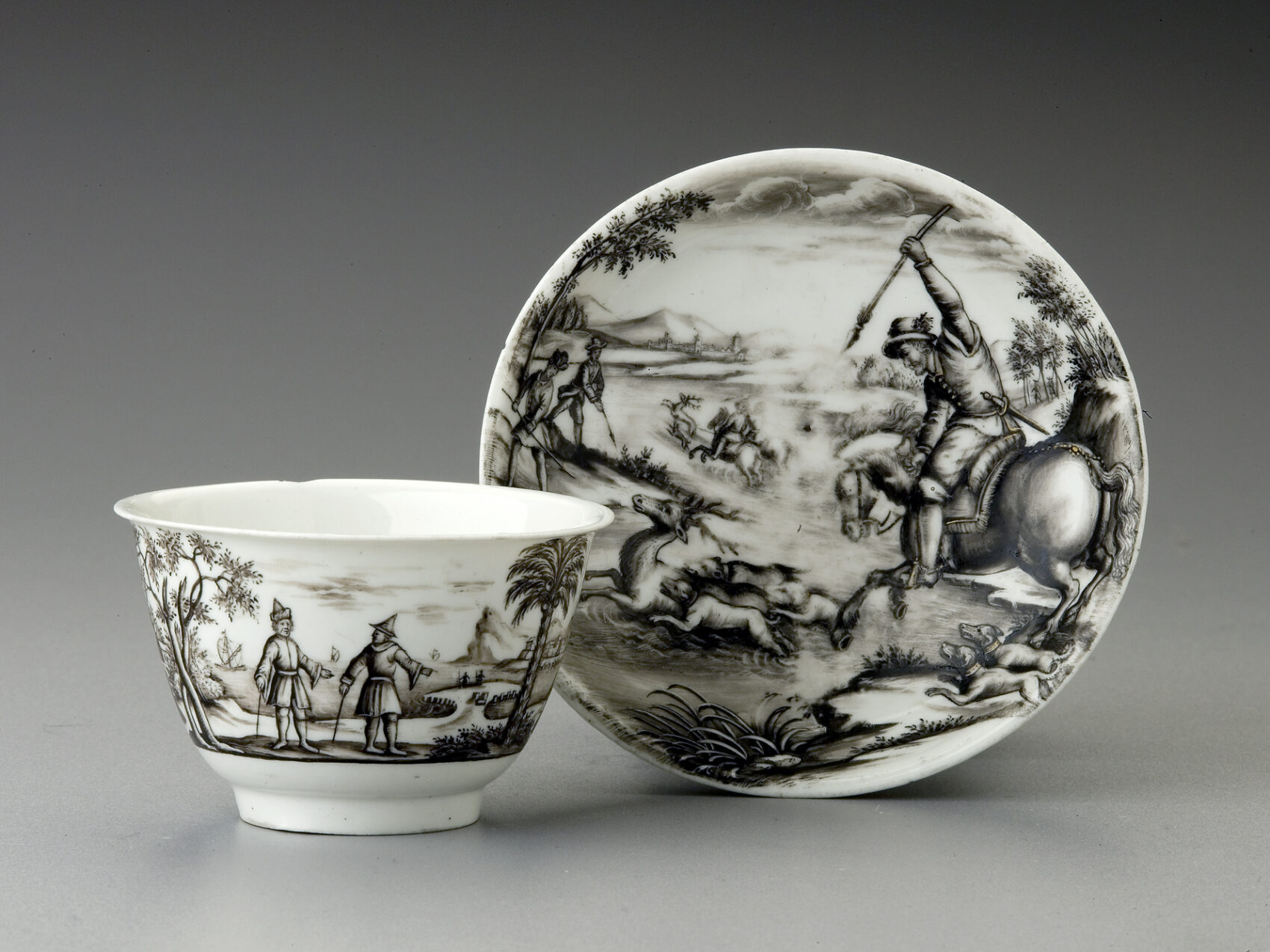
Hunting was a popular pastime and ceremony in aristocratic circles throughout the Renaissance and Baroque eras. The popularity of hunting was reflected in the period designs of luxury glass and porcelain items. Depictions of hunters on horses or animals being hunted are often made in Schwarzlot, a technique that brought fame to the workshop of Daniel and Ignaz Preissler on the Kolowrat estate in East Bohemia. Similar themes were typical for unique items of double-walled glass embellished with designs scratched into gold leaf, whose renown far exceeded the boundaries of the Lands of the Bohemian Crown. Whereas engraved and painted designs on glass and porcelain mostly served a commemorative purpose, hunting rifles with engraved metal components or with stocks intricately inlaid with bone were a testament to their owner’s understanding of the hunt as a representative social event.
Cup and saucer with a deer hunt, c. 1725. Ignaz Preissler (1676–1741), Kunštát (Kronstadt) in the Orlické Mountains. Porcelain, Schwarzlot